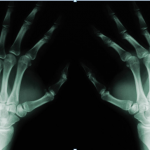A proxy for the level of exposure to prenatal androgens is the length of the second finger digit relative to the length of the forth finger (although not all studies support this link). Lower ratios are generally associated with more male typical behaviors.
A new study published in the journal Development and Psychopathology examines a group of 239 fifth grade children from southeastern China. Aggressive behavior and attention problems were assessed using a Chinese version of the Child Behavior Checklist and Teacher Report Form. Finger lengths were measured directly by study investigators.
Results showed higher levels of both aggression and attention problems to be significantly associated with lower ratios of the length of the second finger relative to the forth for boys but not in girls and for the left but not right hand. The significant effects persisted after controlling for other factors such as early adversity. The effect size was found to be somewhat higher than previous studies in adults.
The authors concluded that exposure to prenatal androgens contributes to aggressive and attention problems in boys.
For those wanting to impress their friends at the next barbeque, it is worth mentioning that the average second to forth finger length ratio was around 0.96 with a standard deviation of only around .03 which may be difficult to assess informally. In addition, the study only examined the digit link with attention problems and aggression, raising the question of specificity and other types of associations that might have been found if the authors had included them in their analyses.
PROGRAM NOTE: For those interested in hearing more about the general topic, the senior author of this study will be presenting at the Department of Psychiatry’s Grand Rounds on Friday September 21 from 10:30-11:45 in the Davis Auditorium across from the UVM Dana Medical Library.
Reference
Liu J, Portnoy J, Raine A. Association between a marker for prenatal testosterone exposure and externalizing behavior problems in children. Development and Psychopathology 2012; 24:771-782.








